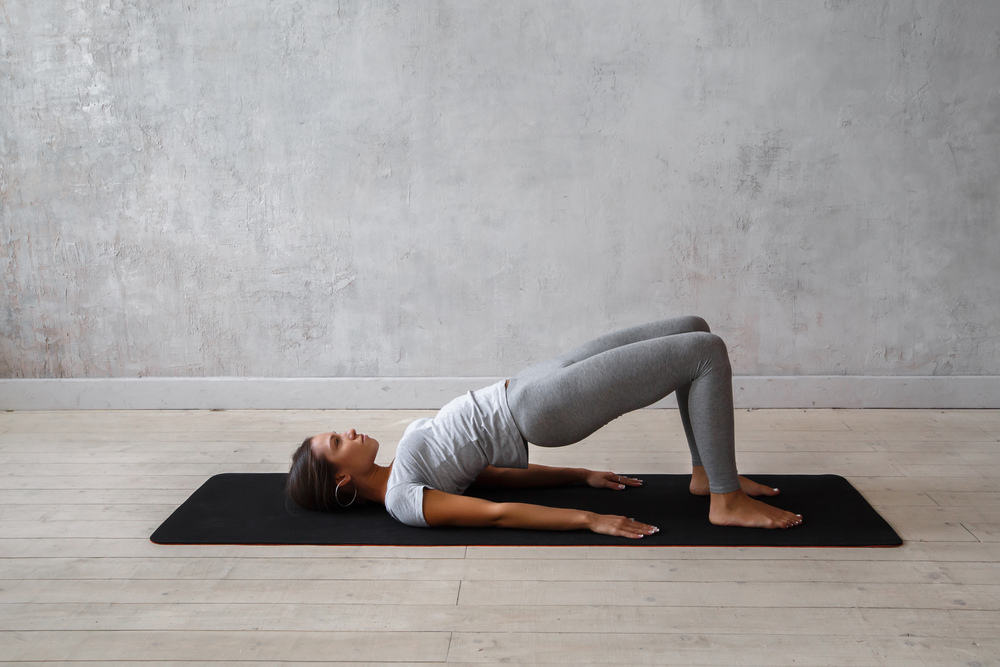Bridge Pose: A Yoga Posture That Brings Body And Mind Wellness
Discover the benefits of bridge pose, a rejuvenating yoga posture that strengthens legs, opens the heart, and ensures a healthy spine — perfect for all levels.
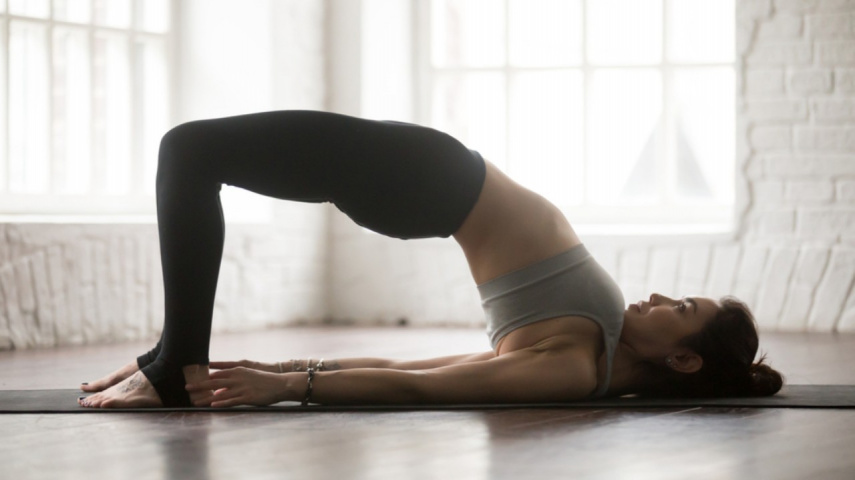
In the ancient language of Sanskrit, Setu Bandha Sarvangasana, known as bridge pose, is a term that brings to mind images of strength and flexibility. Setu means "bridge," Bandha means "lock," Sarva means "all," Anga means "limb," and Asana means "posture." Together, they describe a pose that uses every body part to form a bridge-like structure. This practice is known for its restorative nature, gently coaxing the body into a state of equilibrium.
Bridge posture is often incorporated into yoga routines, especially for beginners. As one of the initial back-bending postures taught, it is an excellent preparation for more advanced poses, such as the wheel pose. By practicing this asana, practitioners can explore heart-opening movements while ensuring the spine's health and strengthening the hips. It provides a holistic approach to well-being through physical engagement.
Bridge pose benefits are numerous. It strengthens the lower body, opens up the chest area, and promotes better breathing and circulation. Adding bridge pose into a regular practice helps individuals focus inward, care for their health, and reap the rewards of a rejuvenated spirit and a calm mind.
How to Perform Bridge Pose
The bridge pose or setu bandhasana is a versatile asana that can be integrated into different parts of your yoga routine. It is an excellent counterpose after an intense abs workout, stretching and relaxing the front of the body. In a back-bending sequence, it can be added dynamically or held statically. To perform the bridge yoga pose perfectly, props can be placed under the lower back to relax and stretch the hip flexor muscles.
Let's explore the steps to accurately perform this pose.
Steps to Perform Bridge Pose
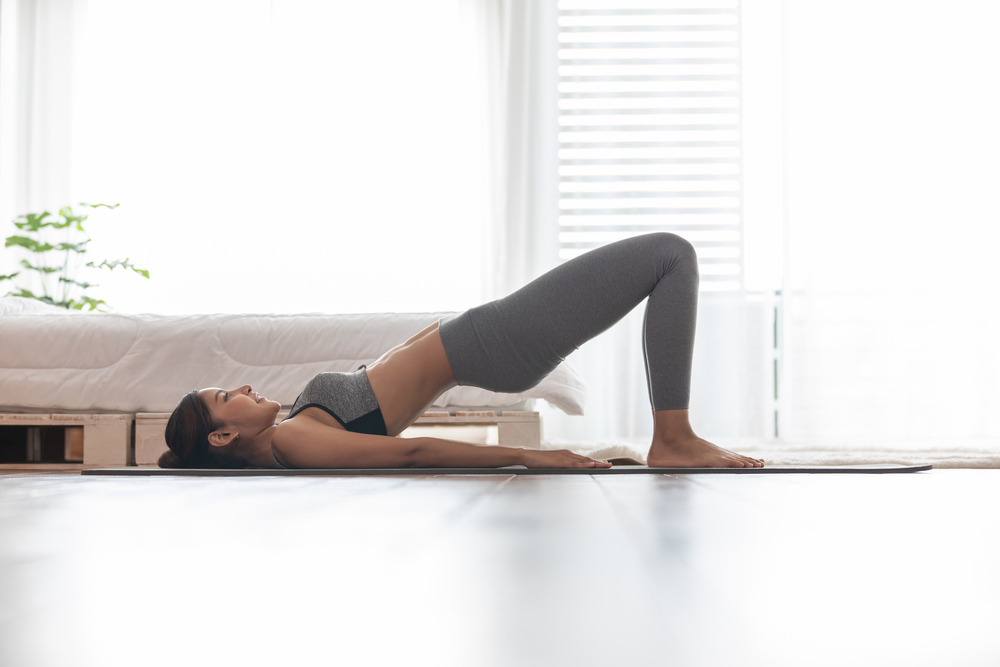
- Start in a supine position. Begin by lying on your back on a yoga mat, ensuring your body is aligned and comfortable.
- Bend your knees, bringing your heels close to your sitting bones.
- Keep your feet flat and put your hip width apart.
- Ensure your hands rest beside your body with palms facing down.
- Press your hands and feet.
- As you exhale, lift your hips towards the ceiling.
- Tuck your shoulder blades under and interlace your hands underneath your back. Press down on your arms and hands while elevating your body.
- Engage your glutes and keep your buttocks off the floor by drawing your tailbone towards your pubic bone.
- Extend your arms and press your forearms into the mat. Ensure your thighs and feet remain parallel.
- Distribute your weight evenly across your feet and elongate your tailbone towards your knees.
- Hold this position for up to a minute. For an added stretch, you may lift your hips higher in the final breaths.
- Gently unclasp your hands and lower your hips and spine vertebrae by vertebrae back to the mat, taking a few deep breaths as you finish the pose.
Mastering the bridge position involves attention to alignment, breathing, and gradual progression. By following these steps, you can confidently integrate this posture into your practice for enhanced flexibility and strength.
4 Key Benefits of Bridge Pose
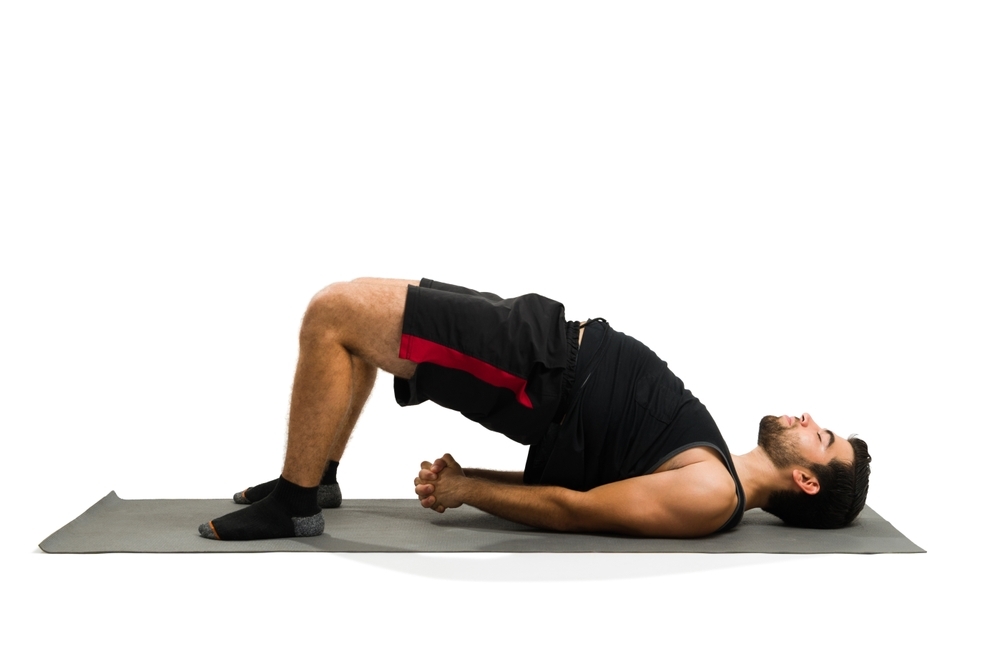
The bridge pose reveals its multifaceted benefits and the importance of practicing it mindfully. From stimulating the thyroid gland to providing modifications for diverse needs, this yoga pose is versatile and adaptable. Safety precautions and variations ensure that practitioners can seamlessly integrate them into their routines for a holistic experience.
1. May Stimulate Thyroid Gland
The bridge position can be good for the thyroid gland, which is found in the area of the throat. This gland helps control body heat, heartbeat, and how the body uses energy (1). Doing this pose increases blood going to the throat area, which can help people with too much or too little thyroid activity.
2. May Relax the Hip Flexors
Sitting for extended periods can lead to tight hip flexors. Practicing the bridge pose helps relax these muscles by extending the hips away from the ground (2). This relaxation is crucial to prevent future issues related to tight hip flexors.
3. May Encourage Spinal Extension
The bridge pose yoga is more of a stretch that extends into the top and bottom parts of the back. As you raise the chest and hips, it makes the upper and lower back stronger, along with the hip joints (3). This can be a fantastic option for beginners to stretch their muscles.
4. May Improve Blood Flow
In this position, lifting the hips higher than the chest helps blood move better to the heart and throat. This better movement of blood is good for the health and working of body parts like organs, joints, and muscles (4).
When you add bridge pose into your yoga practice, you can yield numerous benefits including stimulating the thyroid gland, relaxing hip flexors, encouraging spinal extension, and improving blood flow.
Precautions to Keep in Mind While Performing Bridge Pose
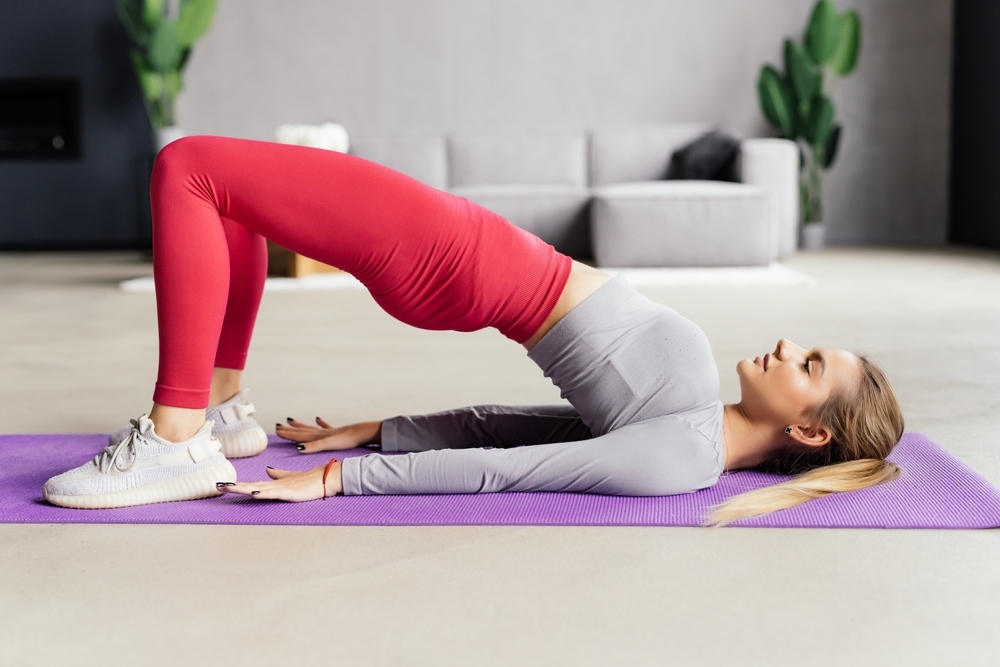
Bridge pose, while beneficial, requires safety precautions to ensure a healthy practice. Here are some tips and precautions to consider:
- High Blood Pressure and Heart Conditions: Individuals with high blood pressure or heart conditions should refrain from practicing this pose.
- Firm Surface Requirement: Ensure that you practice bridge pose on a firm surface, using a yoga mat or a towel on a hardwood floor for stability.
- Hand and Hip Alignment: As you lift your torso and pelvis, place your hands on your hips and ensure your elbows remain parallel while pressing down into your palms.
- Breath Awareness: Utilize your breath to deepen the pose, inhaling to lift your hips higher and exhaling to lower them gently.
- Exiting the Pose: Exit the pose by gradually lowering your back to the floor, moving one vertebra at a time.
- Cervical Spine and Lower Back Concerns: Those with cervical spine injuries or lower back issues should practice this pose with guidance or avoid it altogether.
- Knee Alignment: Ensure that your knees do not flare out excessively while lifting the hips, maintaining alignment with your feet.
Practicing bridge posture mindfully and considering these precautions will enable a safe and rewarding yoga experience.
Bridge Pose Variations And Modifications
The bridge pose, or Setu Bandhasana, is a versatile asana that can be modified to suit practitioners of different abilities and focus areas. Here are some variations to spice up your bridge pose practice.
1. Glute-Strengthening Bridge Pose Variation
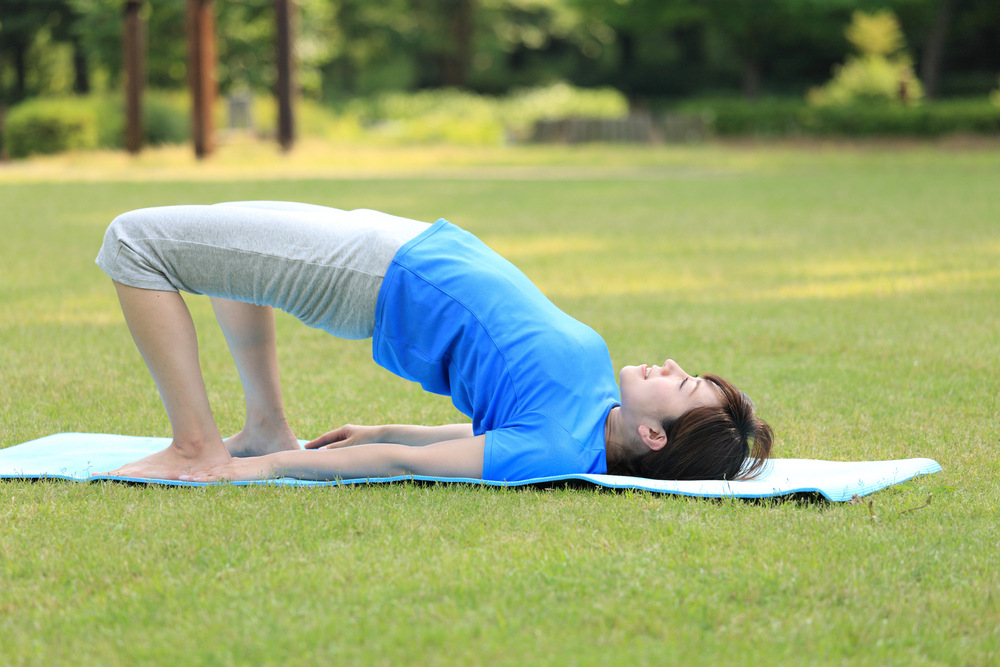
The first variation of the bridge yoga pose is dedicated to strengthening your glutes.
Steps:
- Lie down on your back, bend your knees, and position your feet hip-distance apart.
- Adjust your feet so that your ankles align under your knees.
- Root into your feet and shoulders, lifting your hips one vertebra at a time.
- Hold the posture, drawing your tailbone toward your knees while maintaining a curved back.
- Breathe deeply and hold for a few breaths.
2. Abductor-Strengthening Bridge Pose
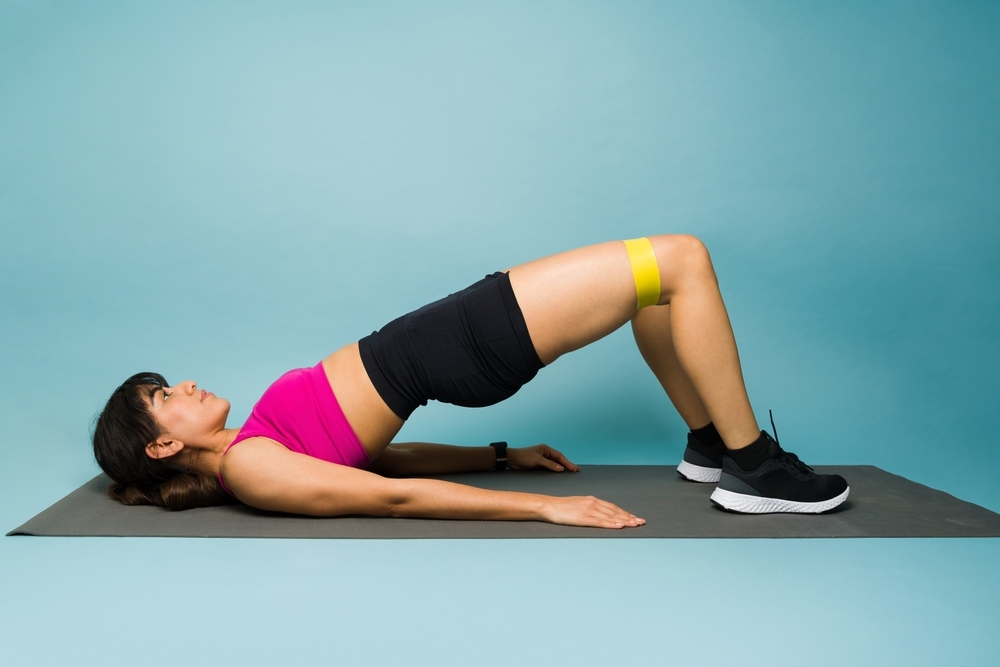
The second variation of bridge pose is deeply connected with toning and strengthening abductor muscles.
Steps:
- Position a looped strap around your thighs, just above the knees.
- Lie down and bend your knees, placing your feet hip-distance apart.
- Press into your shoulders and feet to lift your hips and chest.
- Push your thighs against the strap, maintaining resistance.
- Hold and breathe deeply for a few breaths.
3. Abductor-Strengthening Bridge Pose Variation (With Blocks)
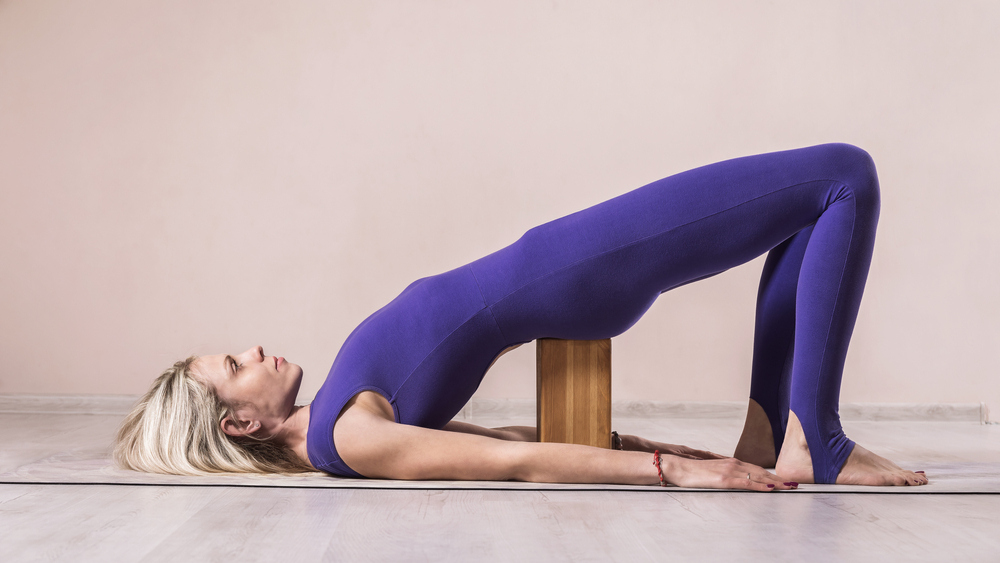
This abductor-strengthening bridge pose variation is to be performed with yoga blocks.
Steps:
- Lie down and place a block between your thighs.
- Bend your knees and align your feet hip-distance apart.
- Squeeze your thighs against the block.
- Lift your hips by pressing into your feet and shoulders.
- Maintain the squeeze and hold the pose for a few breaths.
4. One-Legged Bridge Pose
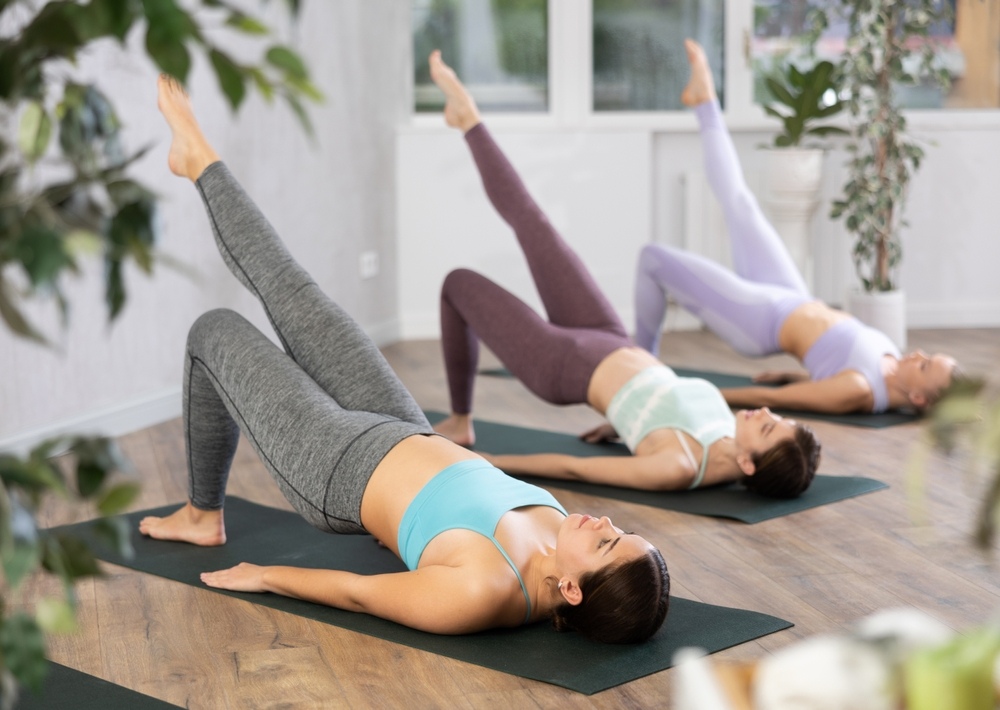
One-Legged Bridge Pose, also known as Eka Pada Setu Bandha Sarvangasana, is a yoga pose where you lift your hips while extending one leg upwards, strengthening the back, and stretching the chest and hip flexors.
Steps:
- Begin by lying down on a yoga mat.
- Bend your legs and place your heels in a hand distance away from your hips.
- Your feet and knees should be in the same line.
- Lift your hips off the mat and keep your thighs parallel to the floor.
- Now press your left foot firmly into the floor and extend your right leg upwards. Keep it perpendicular to the floor.
- Bring your hands together under your back, interlocking your fingers with your arms straight.
- Maintain the pose for eight to 10 breaths.
- Carefully unclasp your hands and lower your spine down one vertebra at a time.
- Repeat the process with the opposite leg.
5. Hamstring-Strengthening Bridge Pose
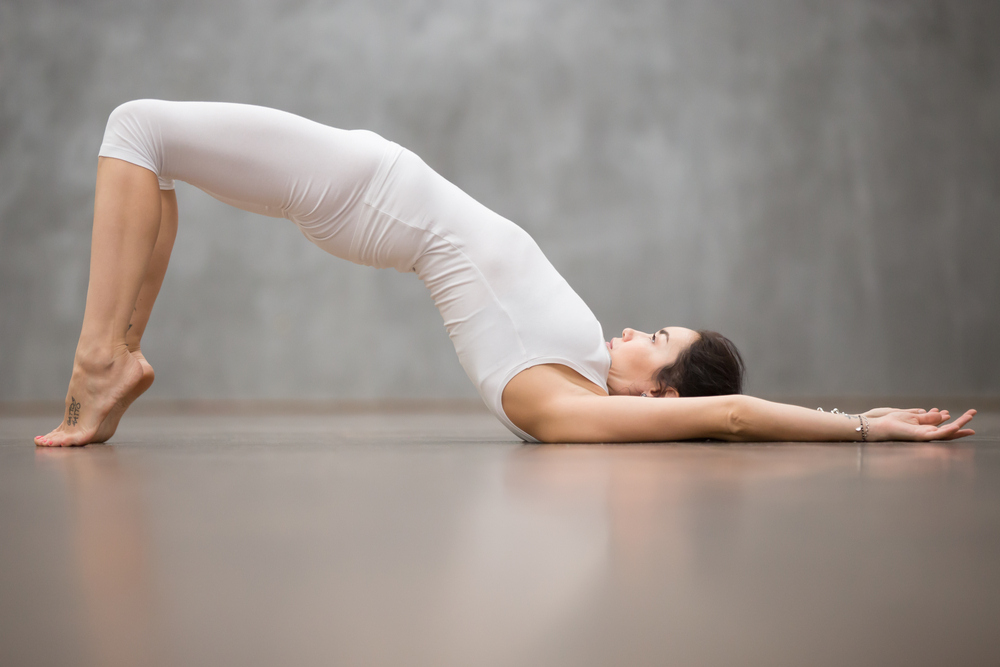
This is another variation of the bridge pose for hamstring strengthening.
Steps:
- Position your mat on a slippery surface and lie down on your back.
- Place a folded blanket near the foot of your mat, or wear socks.
- Plant your feet hip-distance apart on the blanket or floor.
- Flex your ankles, lift your toes, and ground your heels.
- Energetically slide your heels toward you, activating your hamstrings.
- Lift your hips while keeping your toes lifted.
- Slide your heels forward and back, maintaining the height of your hips.
- Repeat the sliding motion for a few deep breaths.
Exploring these variations and modifications in bridge position can help practitioners focus on different muscle groups and adapt the pose to their needs.
Conclusion
Adding the bridge pose to your yoga routine is excellent because it can be changed to focus on different needs, like strengthening specific muscles or improving your posture. Making small changes to a daily yoga routine stops getting monotonous. Being open to change in yoga, like in life, can help you grow. Pay attention to how your body feels with these small changes and use them to improve your yoga practice. Yoga is about connecting with yourself and poses like bridge poses help you find a mix of strength and calmness. So, keep trying new things, listen to your body, and most importantly, have fun with your yoga practice.
ALSO READ: Yoga for Muscle Building to Make Your Body Flexible And Strong





 JOIN OUR WHATSAPP CHANNEL
JOIN OUR WHATSAPP CHANNEL



















































































